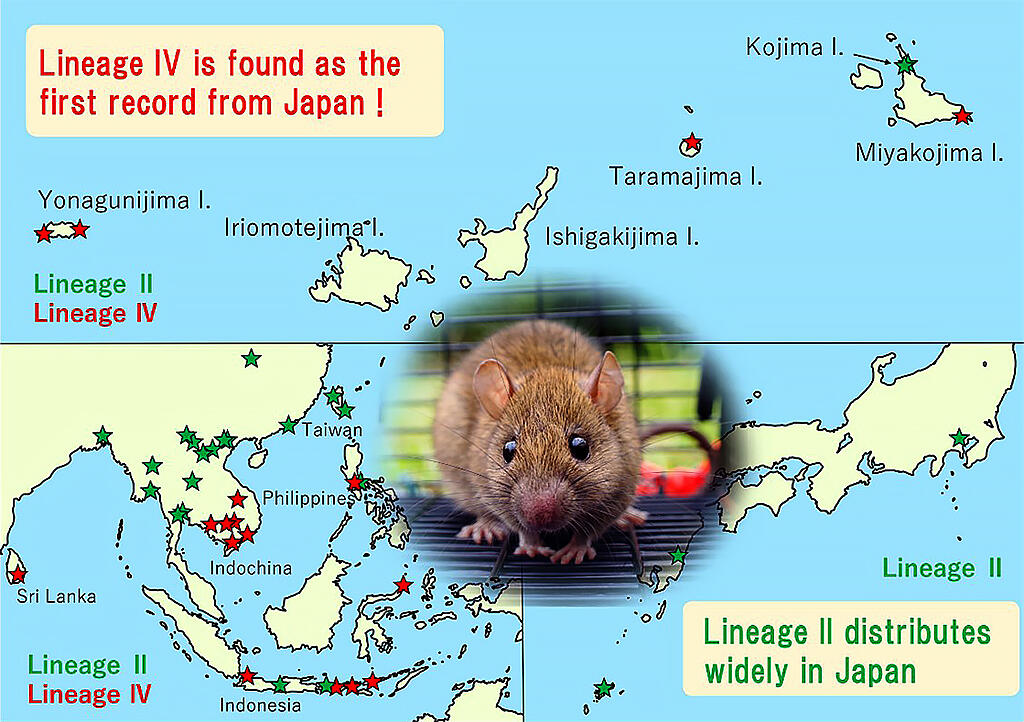A research group comprised of Professor Masaharu Motokawa of the Kyoto University Museum, graduate students Tomohisa Makino, Takashi Yato, and Shinya Okabe of the Graduate School of Science, Kyoto University, in collaboration with the Cultural Property Division of the Okinawa Prefectural Board of Education, the Institute of Regional Studies, University of Okinawa, and the Museum of Nature and Human Activities, University of Hyogo, has discovered for the first time a new lineage of black rat (IV) on the islands of Miyakojima, Taramajima, and Yonagunijima, located in the southern region of the Ryukyu islands, where no rats had been found previously, demonstrating that three lineages of the rat with different evolutionary histories exist in Japan.

Provided by Takashi Yato (Kyoto University)
The black rat exists widely in areas of human habitation, such as homes and farming areas, and has expanded its range greatly coinciding with migrations of people throughout human history. Previous research on mitochondrial DNA has shown that there are six different lineages that can be identified as different species, and it was thought that the black rats in Japan generally belonged to lineages I and II. To further clarify this, the research group carried out surveys on Miyakojima, Kojima, Taramajima, and Yonagunijima, to trap specimens in 2015, 2016 and 2020.
The group then examined the morphological features of the 13 captured specimens, along with the cytochrome b zone nucleic acid sequence of their mitochondrial DNA. By also analyzing the nucleic acid sequences reported in previous research, they found that two individuals from the Hirara Karimata district of Miyakojima and four individuals from Kojima, located off shore of that area, were from lineage II, but that two individuals from the Bora district of Miyakojima, one from Taramajima, and two from Yonagunijima belonged to lineage IV.
Furthermore, analysis of the nucleic acid sequences showed that while the individuals from Miyakojima and Taramajima were similar, they were different from the others. Meanwhile, the individuals from Yonagunijima were different from those from Miyakojima and Taramajima, but belonged to the same cluster as those found in the Philippines, Indonesia, and Sri Lanka. Accordingly, it is believed that the individuals of lineage IV found in the southern Ryukyu islands during this survey are not from a single source. Rather, those found in Yonaguni likely entered from the Philippines, while those found in Miyakojima and Taramajima came from a different region.
According to Professor Motokawa, "Moving forward, we would like to further understand the way diversity arose among black rats that were involved with humans in Asia. Another challenge is the development of a method to identify rats from lineages I, II, and IV, from their coloration and morphology."
■ Cytochrome b zone: In eukaryotes, this refers to the zone in which the cytochrome b gene is encoded in mitochondrial DNA. It is often used for analyzing lineages within and between species.
Journal Information
Publication: BioOne Complete
Title: First Record of Lineage IV of Rattus tanezumi (Rodentia: Muridae) from the southern Ryukyus, Japan
DOI: 10.3106/ms2022-0001
This article has been translated by JST with permission from The Science News Ltd.(https://sci-news.co.jp/). Unauthorized reproduction of the article and photographs is prohibited.




